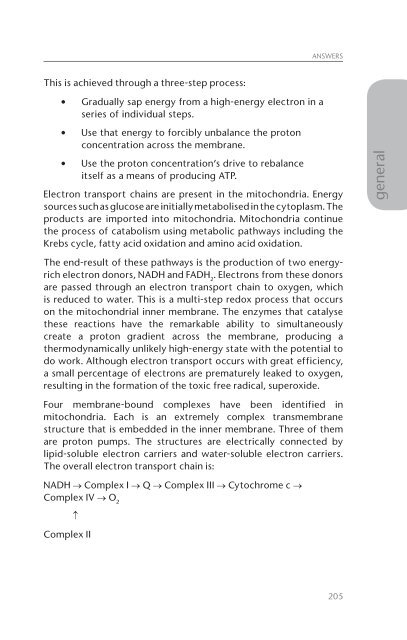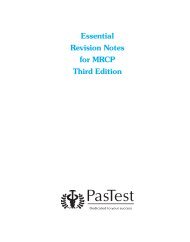ACCESS TO SURGERY: 500 SINGLE BEST ANSWER ... - PasTest
ACCESS TO SURGERY: 500 SINGLE BEST ANSWER ... - PasTest
ACCESS TO SURGERY: 500 SINGLE BEST ANSWER ... - PasTest
Create successful ePaper yourself
Turn your PDF publications into a flip-book with our unique Google optimized e-Paper software.
<strong>ANSWER</strong>SThis is achieved through a three-step process:• Gradually sap energy from a high-energy electron in aseries of individual steps.• Use that energy to forcibly unbalance the protonconcentration across the membrane.• Use the proton concentration’s drive to rebalanceitself as a means of producing ATP.Electron transport chains are present in the mitochondria. Energysources such as glucose are initially metabolised in the cytoplasm. Theproducts are imported into mitochondria. Mitochondria continuethe process of catabolism using metabolic pathways including theKrebs cycle, fatty acid oxidation and amino acid oxidation.generalThe end-result of these pathways is the production of two energyrichelectron donors, NADH and FADH 2. Electrons from these donorsare passed through an electron transport chain to oxygen, whichis reduced to water. This is a multi-step redox process that occurson the mitochondrial inner membrane. The enzymes that catalysethese reactions have the remarkable ability to simultaneouslycreate a proton gradient across the membrane, producing athermodynamically unlikely high-energy state with the potential todo work. Although electron transport occurs with great efficiency,a small percentage of electrons are prematurely leaked to oxygen,resulting in the formation of the toxic free radical, superoxide.Four membrane-bound complexes have been identified inmitochondria. Each is an extremely complex transmembranestructure that is embedded in the inner membrane. Three of themare proton pumps. The structures are electrically connected bylipid-soluble electron carriers and water-soluble electron carriers.The overall electron transport chain is:NADH → Complex I → Q → Complex III → Cytochrome c →Complex IV → O 2↑Complex II205
















